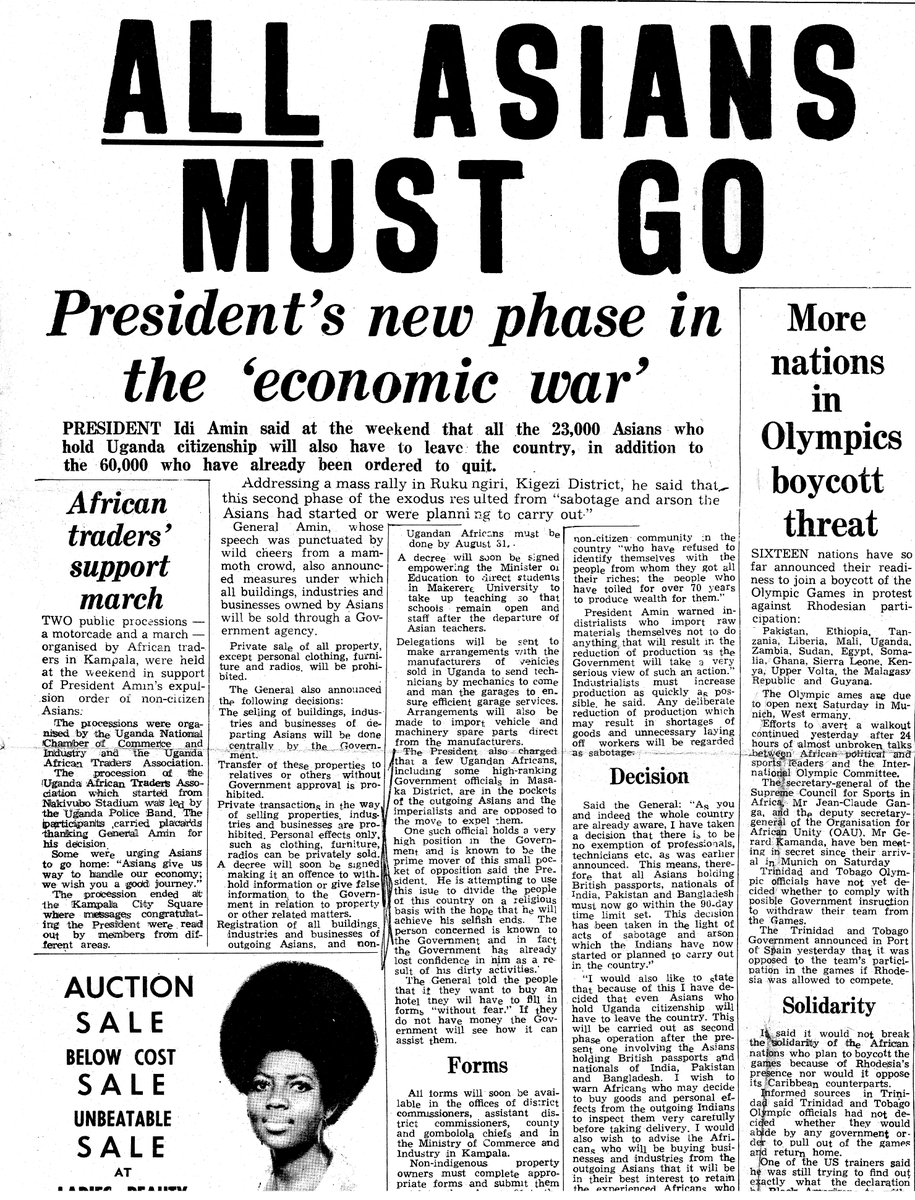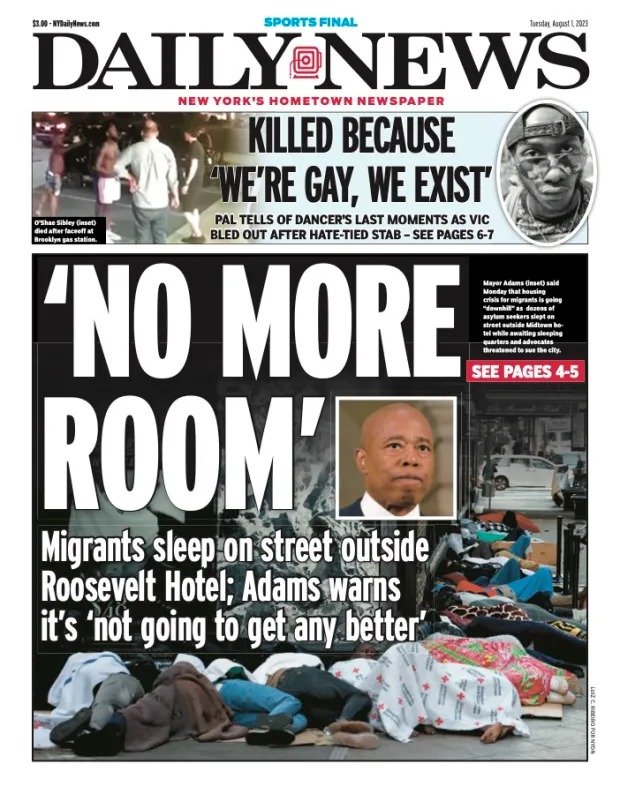Madman or Genius? Idi Amin’s Solution to Illegal Immigration.
Picture this: you’re two years into your new life as an African living in Italy, and you still can’t believe your luck. The initial delay you had planned would've had you in the streets like the rest of these hooligans. So, there you sit at one of those charming little cafés, coffee in one hand, a newspaper in the other. You’ve seen the headlines; Europe is burning, and your people are the culprits. What you feel is a mixture of self-righteous indignation and shame. You hate what they’re doing, you distanced yourself from that country the minute your feet touched the shore, and yet, you know it could've easily been you. Deep down, you know.
By all accounts, life is good; you’re finally in a place where you can fantasize about the future. People in first-world countries take this for granted - the pure pleasure of being able to plan for the future. You’re not yet an actual citizen; you’re still waiting for your papers to be processed, but you like your odds. You spend days wandering the streets, immersing yourself in the sights and sounds of this great country. Isn’t this the place where the mighty gladiators of old fought for their freedom, pride, and future? Here, you feel like a gladiator of sorts. Your opponent: those far-right extremists who view you as the country’s latest threat to its sovereignty, cultural identity, and even its democracy. True to the gladiator spirit, you remain undeterred. Unmoved. "Let them scream," you say, "what do they know about electricity blackouts, roaming the streets for work, watching your children go to sleep on an empty belly?" What do they know about corruption so ridiculous you’d laugh too if it didn’t have a direct impact on your well-being? Last you heard, they discovered half that country’s foreign exchange reserves under the mattress of some public official. Yes, it’s true they don’t want you here, but you’re a poor African, a black man, you’re used to being in places where no one wants you. So, you choose to ignore the hateful looks and slurs. They'd have to drag you kicking and screaming before you'd agree to return.
This is the life of an African immigrant; it's weird in its dichotomy. On the one hand, you’re aware that this land will never truly embrace you; on the other, you’re the envy of your entire village. The apparent reasons for immigration are well-documented: fleeing war-torn regions, oppressive regimes, or in search of better opportunities. However, with the prevalence of illegal border crossings, the immigration question has become so contentious that it's now firmly added to the list of impolite dinner conversations. Immigration makes people nervous, stirs their gastritis, and for some, their stance on the subject is akin to being asked, "Are you racist?"
Europe and the U.S., whether out of guilt or simply the realization that their societies are rapidly changing, have embraced liberal immigration policies, the consequences of which are only beginning to truly sink in.
One of the most frequently cited arguments in favor of a liberal immigration policy is that it results in an influx of skilled labor, an expansion of employment opportunities through the creation of new businesses, and, of course, increased tax revenue. History reminds us that the U.S. was built by immigrants who arrived with nothing but idealism and ambition. Within a few generations, America became a source of admiration and aspiration for the rest of the world - the land of the free. There are very real advantages to adopting a non-restrictive border policy, but precious little is said about the dangers posed by such measures.
A brief examination of the migrant crisis currently afflicting much of Europe and the United States provides ample evidence that sentimental notions and warm "let's spread love" messages hold little weight in the face of the stark realities of immigration. There exists a critical threshold at which migrants transform into immigrants and eventually, illegal aliens in the eyes of the native population. Once this tipping point is reached, the local populace starts to feel threatened by the substantial presence of individuals who look and sound foreign within their community.
However, the issue doesn't lie solely with immigration itself but rather with assimilation. The failure, or in Italy's case, the outright rejection of the host country's values, beliefs, and sometimes even its language, can be a recipe for disaster. When hundreds of people illegally enter a country with no intention of learning the language, adhering to local laws, or engaging with the local population, it inevitably leads to an unsustainable situation, one that fosters an "Us vs. Them" mentality.
But what does it truly mean to assimilate into a new country? Assimilation transcends the mere adoption of the local language, although that is a good starting point; it entails much more. According to the article titled "Assimilation" from the Encyclopedia of Global Studies, ‘Assimilation is a much-contested notion whereby on entering a new country, immigrant groups are encouraged, through social and cultural practices and/ or political machinations, to adopt the culture, values, and social behaviors of the host nation in order to benefit from full citizenship status.’ When successfully achieved, the immigrant is expected to shed any distinctive identifiers from their country of origin and undergo a transformation into a new person. A rebirth of sorts that influences terms of language, behavior, music taste, heck even dress code. No, you can’t wear a kanzu to work in Italy.
“In the U.S. model prevalent for the first part of the 20th century, new immigrants were encouraged to “Americanize” in order to achieve social stability and economic success and minimize so-called self-segregation between communities. In terms of social relations, it was thought that assimilation, or cultural homogeneity, would lead to less conflict between groups as they came together under one belief system. In economic terms, it was believed that the more diverse groups were able to integrate into dominant modes of production and consumption, the more chance there was for a stable economy. In this regard, assimilation has not always had negative connotations. It was seen as a way to enhance the social mobility and economic opportunities of new entrants into the country and contribute to the social and economic stability of the host nation.” - Assimilation from Encyclopedia of Global Studies
So, what happens when assimilation fails? Historically, the failure to assimilate has been a primary driver of anti-migrant sentiment, dating back as far as the 19th century. For instance, in 1882, Chinese immigrants residing in the U.S. encountered significant hostility due to their inability to assimilate. To the average American, it seemed as though the Chinese were attempting to establish a "little China" within U.S. borders and decided they had enough problems of their own. This hostility ultimately resulted in the signing of the Chinese Exclusion Act, effectively halting Chinese immigration for nearly a decade.
Similarly, in the 19th and 20th centuries, Northern England and, in more recent times, Japan during the 1980s and 1990s experienced tensions between the local population and migrants who failed to embrace the cultural practices of the host community.
On their part, except for the U.S., which historically imposed assimilation on immigrants (although due to recent diversity and inclusion policies, this practice is no longer enforced), most immigrants staunchly resist assimilation. They perceive assimilation as a threat to their cultural identity, language, and values. Consequently, when they migrate to a new country, they bring everything with them except the physical borders. They often cluster in the same areas and construct their own unique communities within the host country's borders. This isn't inherently negative; if placed in their shoes, it's difficult to imagine raising our children in a different country with values diverging from those handed down by our ancestors.
The issue arises when this minority migrant population gradually becomes the majority and starts to influence national policies, particularly if they achieve more success than a significant portion of the native population. When this occurs, there is only one direction things can go, and it tends to be a downward trajectory.
From a Ugandan perspective, immigration hasn't been a top concern since the era of President Idi Amin. However, as with many of Uganda's issues, it was largely overlooked until a knee-jerk reaction resulted in the expulsion of all Asians from the country. In the 1960s, Asians in Uganda struggled to assimilate with the local population. ‘Struggled’ being the politest way of phrasing it. Whether it was a consequence of colonial policies that physically and socially segregated the locals from their Asian counterparts or deeply ingrained prejudices fueled by false stereotypes, the two communities rarely interacted in any meaningful way. In retrospect, it appeared as though the Indian community in Uganda had established a "little Bombay" within Kampala. Reports surfaced of discrimination against Ugandans, a lack of knowledge sharing with the local population, and outright racism.
Idi Amin's presidency has since been acknowledged as one of the most brutal periods in Uganda's history. Yet, despite his brutality, Amin is regarded as a hero by the average Ugandan because he forcefully reclaimed the country's economy from the Asian minority. At the time of their mass exodus, Amin was considered a madman, a disgrace, and a dictator. It’s true he might have been all these things and yet, isn’t it curious that a few decades later, developed countries find themselves contemplating taking the same route.
Today’s Uganda, much like your grandfather's battered Mercedes, continues to trudge forward, leaving onlookers - both donors and recipients - in awe. We're navigating this journey like a John Coltrane piece, relying on improvisation for everything, addressing what we can while overlooking the rest. However, history has taught us that neglected issues are like festering wounds; left untreated, they can infect and harm the entire body, one organ at a time. Watching from the sidelines, it seems as though our country's immigration policy was scribbled on a paper napkin during an impromptu coffee meeting. A simple visit to areas like Kansanga, Kabalagala, Old Kampala, and the like might leave you questioning which side of the border you’re standing on.
"The refugee population in Uganda is a result of its tumultuous neighborhood, marked by civil war in South Sudan and ethnic conflict in the Democratic Republic of the Congo (DRC), which has compelled hundreds of thousands to flee in recent years. However, it is also an outcome of policies often hailed as among the most generous in the world. UN High Commissioner for Refugees Filippo Grandi has praised the 'Uganda model,' which allows refugees to work, cultivate land, and move about freely—rights seldom extended to such an extent in other countries of first asylum. In many of these countries, arrivals are typically seen as competitors for jobs and scarce resources. Additionally, refugees in Uganda have access to government-provided healthcare and primary education."
As the liberals in America slowly backtrack from their earlier support of Obama/Biden’s immigration policies, we might want to take a cursory look at that napkin of ours and consider if we might not, in due time, face the same predicament. In time, I’ll leave you with the words of the most quoted British Prime Minister:
"Those who don't know history are doomed to repeat it." - Sir Winston Churchill


0 Comments Add a Comment?